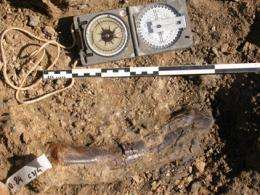One of France's largest dinosaur fossil deposits found in the Charente region

The first excavations at the Audoin quarries in the town of Angeac, in the Charente region of south-western France, have confirmed that the site is one of the richest dinosaur fossil deposits in the country.
Coordinated by the Musée d'Angouleme and the Géosciences Rennes laboratory (France), the project involved researchers from CNRS and the Muséum National d'Histoire Naturelle (French Natural History Museum).
With more than 400 bones brought to light, this site is remarkable both for the quantity of discoveries and their state of preservation. The quarries have yielded a wide variety of fossils dating from the Lower Cretaceous Period, dating back 130 million years. The most impressive is a femur exceeding 2.2 meters, which could have belonged to the largest sauropod known in Europe. Unusually, the paleontologists at the site also discovered fossilized wood, leaves and seeds that will enable them to reconstitute the flora in which the animals lived. Based on these exceptional finds, the scientists hope to gain a clearer picture of the terrestrial ecosystems of the Lower Cretaceous, a little-known and insufficiently documented period in this region of Europe.
Although its existence had been suspected for years, the dinosaur fossil deposit in Angeac-Charente, near Angoulême, was only discovered in the Audoin quarries in January 2010, and turned out to be one of the largest paleontological sites in France. Covering several hundred square meters, the site consists of argillaceous strata from the Lower Cretaceous Period buried under the ancient quaternary alluvial deposits of the Charente River. The first excavation campaign took place over 20 days from late August to early September this year.
Remains of herbivorous and carnivorous dinosaurs mixed with aquatic species
These initial excavations have already unearthed more than 400 bones, over 200 of which are of great scientific interest. The latter come from at least 3 dinosaur species, found alongside the remains of two types of turtle and three species of crocodile. The find is all the more exceptional as the bones are not only present in large numbers, but are also remarkably well preserved, having been buried rapidly in the argillaceous sediments of a marsh that covered the Angeac-Charente region during the Lower Cretaceous.
The most impressive finds are indisputably the remains of the largest known sauropod in Europe. Its femur, which has for the moment been left in situ, exceeds 2.2 meters in length, suggesting a weight of some 40 tons and a body length of about 35 meters. The biological links between this giant herbivore and other species have yet to be determined, but its anatomy is not dissimilar to examples found in Spain and dating from the same period. The presence of small herbivorous dinosaurs has also been evidenced by the discovery of a tooth and a few bones. The most abundant fossil material gathered this summer (nearly 80% of the bones exhumed) belongs to a large carnivorous dinosaur with a body length of about 9 meters. The number of femurs found points to no fewer than five individuals, young and adult.
Dinosaurs from the Lower Cretaceous are rarely found in France, and are usually identified on the basis of fragmentary remains. So far only three dinosaur genera have been identified: the ornithopod Iguanodon and the two theropods Genusaurus and Erectopus. Richer faunas, most likely contemporary with that of the Angeac site, have been described in Britain (in particular on the Isle of Wight) and Spain (Cuenca Province). The most remarkable animal remains from the period, including feathered carnivorous dinosaurs, were found in the Liaoning Province of China. The newly-found Angeac dinosaurs will be compared to these other specimens to determine their shared and distinctive characteristics.
For the paleontologists involved in the project, the next step will be to study and analyze their discoveries, whether it be the animal bones or the fossilized plants. In parallel with this scientific research, a project will be undertaken to enhance the site, enabling the public to view each phase of the operation, from excavation to museum display, over the next few years.
Provided by CNRS



















